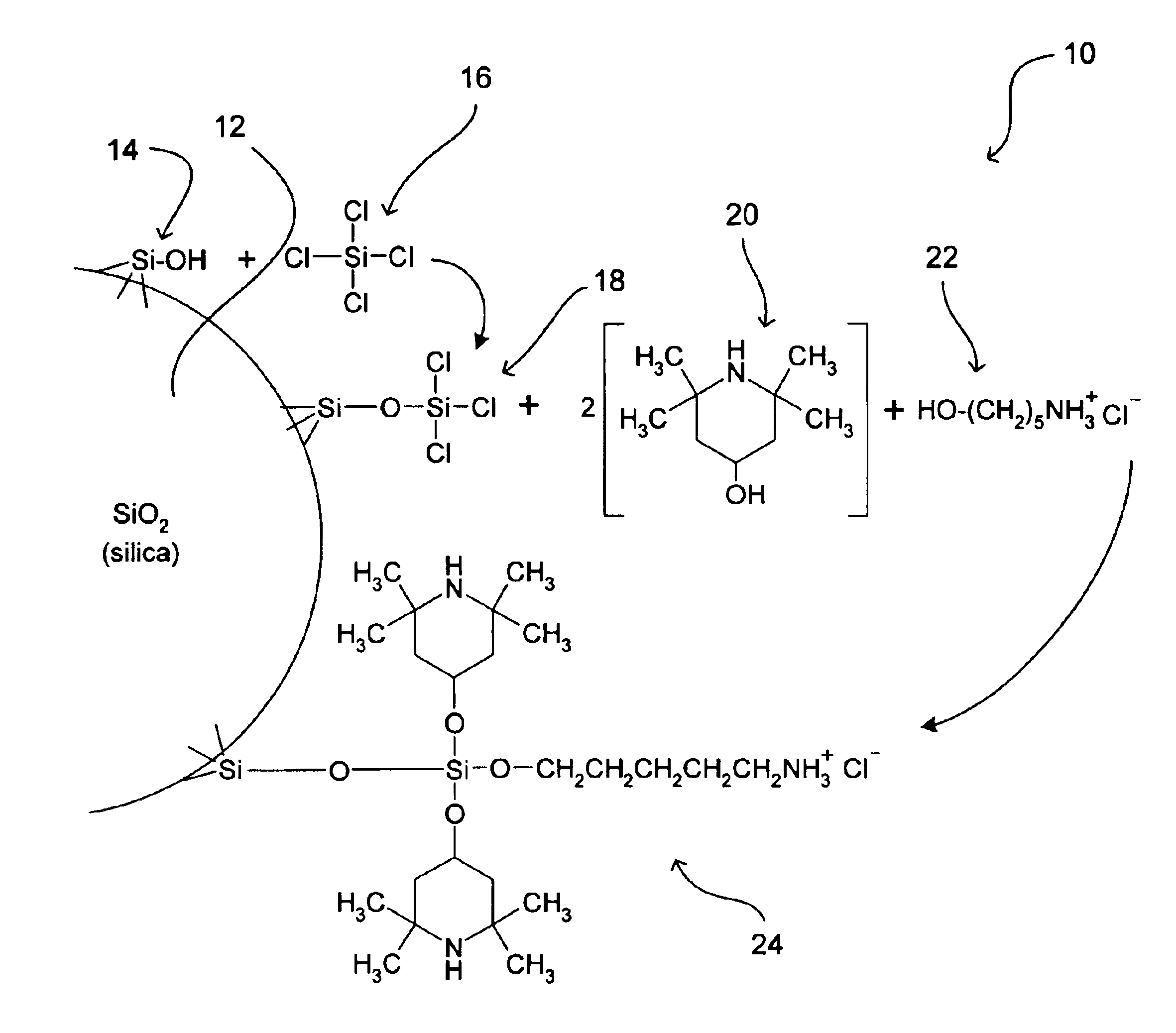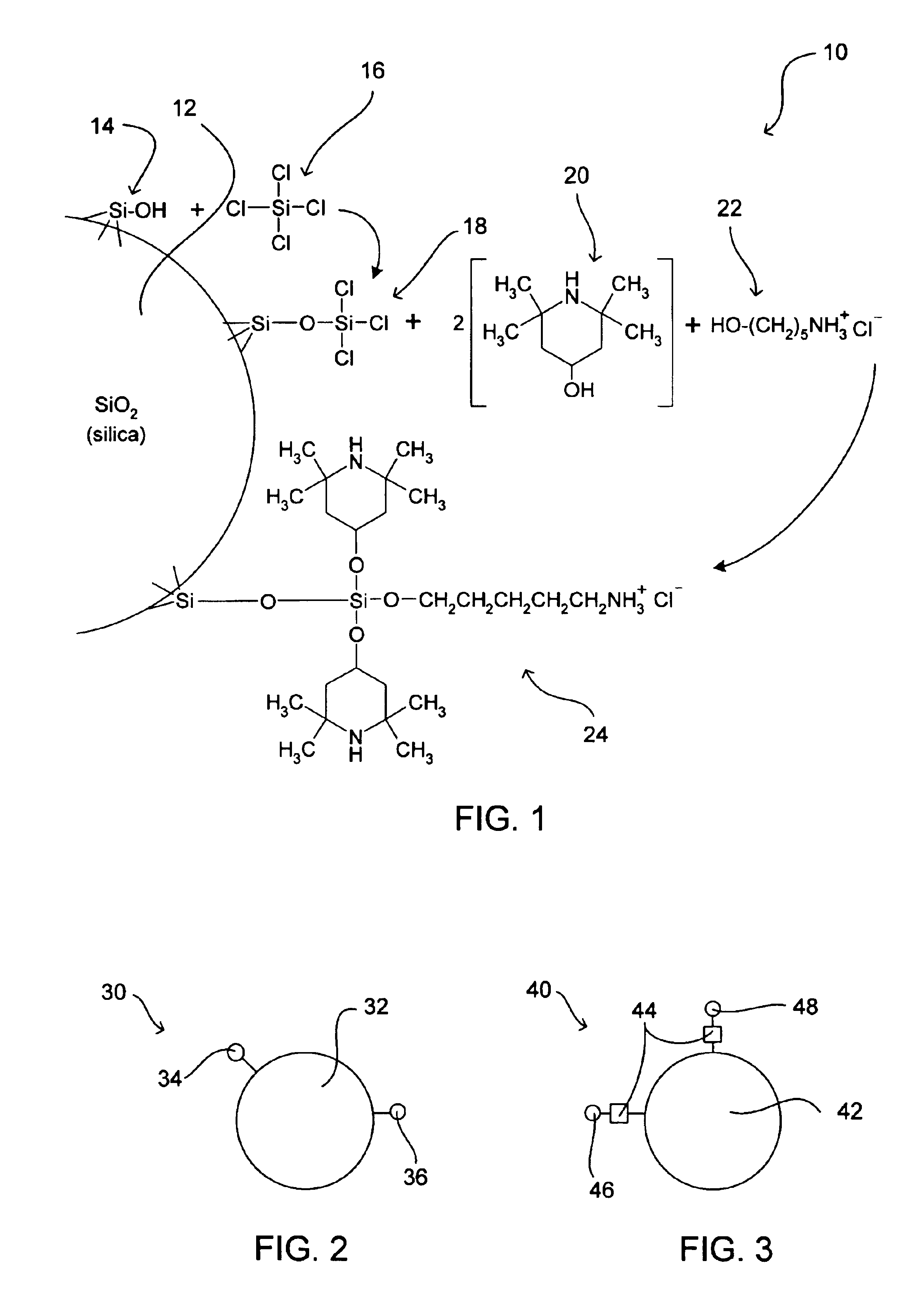Chemically-modified coatings for enhanced performance of ink-jet images
a technology of inkjet printing and chemical modification, applied in the field of inkjet printing, can solve the problems of reducing the reliability of inkjet pens containing these modified inkjet inks, and poor photo-oxidative color stability and moisture resistance, so as to enhance the image permanence of inkjet images and enhance the effect of image permanen
- Summary
- Abstract
- Description
- Claims
- Application Information
AI Technical Summary
Benefits of technology
Problems solved by technology
Method used
Image
Examples
example 1
[0049]A series of commercially available modified silicas available from Waters, Mass. USA, (where the active group is aminopropyl, cyanopropyl, or octadecyl), including the corresponding unmodified counterpart, used in high performance liquid chromatography, was hand-coated onto photographic substrates, using polyvinyl alcohol as the binder. Lines of cyan, yellow, magenta, and the red, green, blue colors formed by appropriately mixing these primary colors were printed at an initial width of 40 mils. After being allowed to dry, the print samples were allowed to equilibrate at a temperature of 35° C. and 80% relative humidity for four days. The line widths were measured. The Table below shows the increase in line width as a result of exposure to high temperature and humidity. This increase is a measure of humid fastness; the higher the increase, then the poorer the humid bleed performance. It is observed that the modified silica performed much better than the unmodified counterpart.
[...
example 2
[0051]Silica (Sipemat 310) marketed for ink-jet applications by Degussa Huls, Waterford, N.Y., was modified with the reagent shown below:
[0052]The reaction was carried out in dry methanol under dry nitrogen for six hours. Excess reagent was used in the reaction; as such the unreacted reagent was extracted with dry methanol. The product was dried and elemental analysis showed that it has a carbon content of 9%, confirming that indeed the reaction was successfully completed. The product was coated onto a photographic substrate, using polyvinyl alcohol as the binder. Its image fade (light fastness and air fastness) was compared with the unmodified counterpart. For an experimental magenta dye based ink (magentas in general have the poorest image fade), the modified silica had an accelerated light fastness of 28 years; in the same test, the unmodified counterpart had an 11 year light fastness. Likewise, in an accelerated air fade test, the modified silica showed 2 to 3 times improvement...
example 3
Siloxane Coupling of Glucose Photo-Stabilizer to Silica Pigment
[0053]A 0.73 g amount of Aerosil 380 silica pigment was dried under vacuum for 3.5 hours at 150° C., cooled to room temperature, and flushed with nitrogen in a flask to void moisture. About 25 mL of dichloromethane solvent was added to the flask containing the silica, stirred to form a slurry, and purged with nitrogen for 10 minutes. To this solution, 0.2 mL of dichloro tetramethyl siloxane (Aldrich) was added, followed by the addition of 0.1 mL of triethylamine. The solution was then continuously stirred for 2.5 hours at room temperature. The resulting solution was centrifuged for 10 minutes and the precipitate washed twice with dichloromethane. The washed precipitate was mixed with 20 mL of dichloromethane solvent to which 0.4 g of D-glucose (Aldrich) and 0.5 mL of triethylamine was subsequently added and stirred overnight at room temperature. The primary alcohol on the glucose was used as a bonding group.
PUM
| Property | Measurement | Unit |
|---|---|---|
| width | aaaaa | aaaaa |
| temperature | aaaaa | aaaaa |
| temperature | aaaaa | aaaaa |
Abstract
Description
Claims
Application Information
 Login to View More
Login to View More - R&D
- Intellectual Property
- Life Sciences
- Materials
- Tech Scout
- Unparalleled Data Quality
- Higher Quality Content
- 60% Fewer Hallucinations
Browse by: Latest US Patents, China's latest patents, Technical Efficacy Thesaurus, Application Domain, Technology Topic, Popular Technical Reports.
© 2025 PatSnap. All rights reserved.Legal|Privacy policy|Modern Slavery Act Transparency Statement|Sitemap|About US| Contact US: help@patsnap.com



